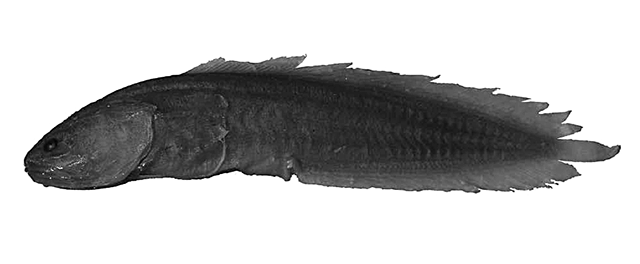| Dinematichthyidae (Viviparous brotula) |
| 4.8 cm SL (male/unsexed); 5.2 cm SL (female) |
|
reef-associated; marine; depth range 5 - 10 m |
| Western Pacific: Philippines. |
|
Dorsal soft rays (total): 78-87; Anal soft rays: 54-66; Vertebrae: 42-44. This species is distinct with the following characters: D 78-87, A 54-66, D/A 22-27, V in D 2.2-2.4; vertebrae 12-13+29-32=42-44; anterior nostril located 1/4 the distance from upper lip to aggregate distance to anterior margin of eye; free pseudoclaspers 2 pairs, outer pseudoclasper wing-shaped with broad base and distally slightly widened supporter without anterior hook, the inner one moderately long, with widened base, distally with 2 inward directed strong spines; cheeks with 5-6 scale rows on upper part and 3-4 rows on lower; no upper preopercular pore; otolith moderately elongate, its length to height is 2.0-2.1, pointed anterior and posterior tips, short sulcus with ventral indentation at joining of ostium and cauda, partly fused colliculi, its centre anterior to centre of otolith, inclined about 10°, otolith length to sulcus length is 2.0-2.1 (Ref. 76869). |
| Inhabitant of reef crevices, cryptic and solitary (Ref 90102). |
|
Least Concern (LC); Date assessed: 02 March 2017 Ref. (130435)
|
|
|
Type locality, off Talampetan, Busuanga Island, Palawan, WAM P.31397-010 (holotype of Ungusurculus philippinensis, 3.7 cm SL, male). Observed to be fairly common along the shores of the central Philippines from Palawan to Panay, Negros and Mindanao (Ref, 76869). Also in Apo Island, Siquijor Island, Guimaras Island and Calamianes Islands (Ref. 90102). |
Source and more info: www.fishbase.org. For personal, classroom, and other internal use only. Not for publication.

